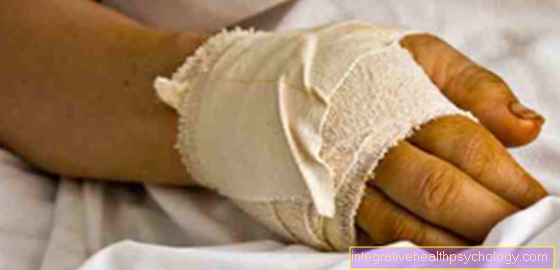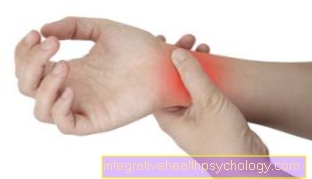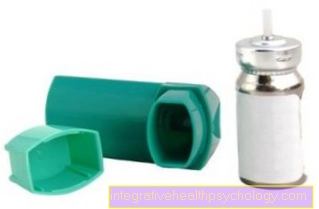plaster
introduction
Everyone has seen it before and many have worn it themselves - one plaster cast.
The out hard plaster existing association is a means of conservative therapy of damage to the anatomical structures. These are not just those bonewith which most associate a plaster of paris, but also those Joints, the Tapes and the Tendons. The plaster cast is intended to cover the injured structures stay calm, thus preventing the damage from worsening and allowing quick and safe healing.

Plaster of paris can be used for various injuries and disease processes conservative therapy can be used. He especially plays with traumatic (accident-related) damage such as uncomplicated broken bones, bruises, strains and Tears in ligaments or Tendons a major role.
Complicated fractures, in which the fracture point is displaced or bone fragments are present in the surrounding tissue, should not only be provided with a plaster cast, but operated on become. After operations, a cast can be applied to improve immobilization.
Also at non-traumatic changes how inflammatory processes on bones or joints Scoliosis (Curvature of the spine) and Misalignments in newborns or children (Clubfoot, Perthes disease) a plaster cast can help heal.
Plaster molds
The immobilization of the extremities (arms and hands, legs and feet) can be done individually in different positions and certain degrees of firmness:
A Round plaster encompasses the entire circumference of the limb. It is a closed plaster cast that does not allow great expansion.
A Gap plaster is initially applied like a round plaster. After a hardening phase, the plaster cast is sawed lengthways, leaving a gap of about 1 cm in the plaster of paris. Elastic bandages are wrapped around the plaster of paris to secure it. If the extremity swells, the tissue has room to expand.
At a Plaster bowl becomes about half, with one Plaster splint covers less than half of the injured limb. The shell or splint should mostly only prevent a certain movement and ensure the immobilization in one plane.
A so-called Plaster tutor completely envelops an extremity. For example, the patient's leg from the lower leg to the upper leg, including the knee joint, is cast in plaster.
Should the Spine can be straightened or immobilized, the Back shell or a Plaster corset are used. The former covers only half of the torso, while a plaster corset, like a conventional corset, covers the entire torso from the pelvis to the chest.
Appointment with ?

I would be happy to advise you!
Who am I?
My name is dr. Nicolas Gumpert. I am a specialist in orthopedics and the founder of .
Various television programs and print media report regularly about my work. On HR television you can see me every 6 weeks live on "Hallo Hessen".
But now enough is indicated ;-)
In order to be able to treat successfully in orthopedics, a thorough examination, diagnosis and a medical history are required.
In our very economic world in particular, there is too little time to thoroughly grasp the complex diseases of orthopedics and thus initiate targeted treatment.
I don't want to join the ranks of "quick knife pullers".
The aim of any treatment is treatment without surgery.
Which therapy achieves the best results in the long term can only be determined after looking at all of the information (Examination, X-ray, ultrasound, MRI, etc.) be assessed.
You will find me:
- Lumedis - orthopedic surgeons
Kaiserstrasse 14
60311 Frankfurt am Main
You can make an appointment here.
Unfortunately, it is currently only possible to make an appointment with private health insurers. I hope for your understanding!
For more information about myself, see Lumedis - Orthopedists.
What materials are there?
Of the stabilizing part real plaster casts consists of plaster. But nowadays too Plastic rails referred to as plaster, although no plaster was actually used. In addition to the hard parts of a plaster cast, many other materials are used to ensure the greatest possible stabilization and a comfortable fit.
Usually a hard bandage consists of four layers: one skin protection, of the upholstery, the Hard material and one coating. The skin protection in the form of a tubular bandage (a type of tubular gauze bandage) is intended to protect it from irritation caused by the plaster cast and thus increase the comfort and cooperation of the patient. The padding, which consists of a thick layer of cotton wool, comes over the bottom layer. This is wrapped with crepe paper so that the cotton does not come into contact with the plaster and become hard. The third layer, the hard material, is applied either in the form of wet plaster bandages or as a plastic splint. The top layer is made of the same material as the skin protection. A gauze bandage is wrapped around the cast or a tubular bandage is pulled over it. If necessary, the plaster of paris can then be wrapped again with a bandage of stronger, self-adhesive plastic bandages.
What type of bone fracture?
In principle, plaster casts can be used for all uncomplicated fractures of the extremities without prior surgery. All other Broken bones must first be treated surgically before a decision can be made whether to apply plaster of paris. The upper extremities include the upper and lower arms, hands, and fingers. The lower extremities include the thighs, lower legs, feet and toes, although broken toes are usually not put on a cast or splint.
A broken bone must have some criteria to be classified as uncomplicated:
The break must locked - no bone parts should protrude from the fracture site. The break is allowed not postponed be (displaced). If the breaking edges are shifted, the edges must either be brought closer traumatically (with force) or an operative correction of the position must be carried out. It may no multi-fragment fracture (multiple fractures, up to 6 bone parts) and no comminuted fracture (the bone is broken or splintered into more than 6 pieces). Corresponding broken bones must first be treated surgically. Also Bone fragmentsthat would not affect bone healing per se must be removed before a plaster cast. Otherwise there is a risk of inflammation followed by impaired wound healing.
Wearing time
The length of time the cast must be worn depends on the severity of the injury and the location. Some patients get rid of the cast after a week, others only after 10 weeks.
The following are some examples of situations that may require the application of a cast:
- Short-term immobilization after finger surgery: 1 week
- Healing of tendinitis: 4 weeks
- Immobilization of wrist injuries, strained ligaments, hairline cracks in the carpal bones or the forearm: 1 - 4 weeks
- Immobilization of fractures of the forearm bones near the wrist (ulna and radius): 4 - 5 weeks
- Immobilization of fractures in the elbow region: 5 - 6 weeks
- Immobilization of broken bones, ligament or tendon damage at the ankle joint of the foot: 5 - 8 weeks
- Immobilization of a scaphoid fracture: 10 weeks
Pain in the cast
By wearing the plaster casts for a long time, various Complications occur that can cause pain:
If areas of the skin where there is no noticeable muscle layer above the bone (wrist, ankle), are not properly padded, it can Bruises come. The skin becomes chafed, sore and can burning pain cause.
In addition, the muscle begins to break down from the moment it is immobilized. Through the Loss of muscle mass and the restricted mobility can be too Muscle and joint pain come. The latter can stiffen during the resting phase and cause pain when moving again.
Another possibility, which is more likely to affect the legs, is Thrombosis. In the case of a thrombosis, the reduced movement causes a blood clot to settle in a leg vessel, clog it, impede the supply of the tissue behind it and thus cause pain. Preventive treatment with Blood thinners (Clexane injections) can prevent thrombosis.





























